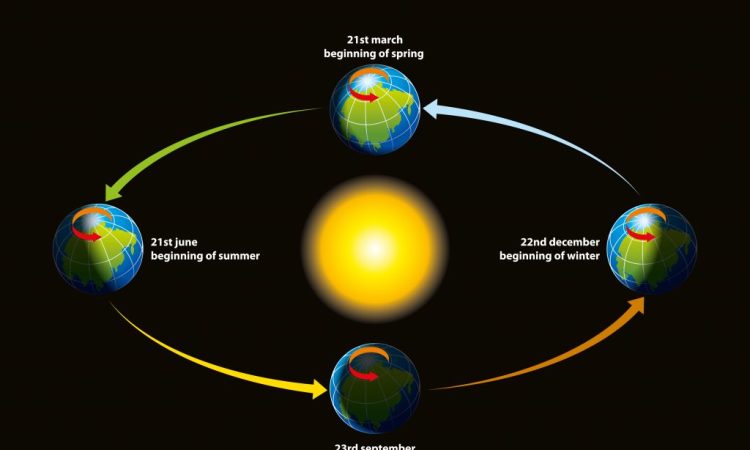
The succession of seasons allows the entire surface of the Earth to benefit from the positive influences of solar radiation, the engine of all terrestrial activity and of the entire water cycle
The Earth is a unique planet in the solar system and, for now also in the (for now!). The presence of water in a liquid state, an atmosphere rich in oxygen, with the right greenhouse effect to have an ideal temperature, has allowed the impressive development of life. The succession of seasons allows the entire surface to benefit from the positive influences of solar radiation, the driving force of all terrestrial activity and of the entire water cycle.
Advertisement
Have you ever wondered what causes the seasons?
Certainly not due to the variable distance from the Sun, also because in summer (in the northern hemisphere), when it is warmer, the Earth is further from the Sun than in winter by about 5 million km. The succession of seasons is determined solely by the inclination of the Earth’s axis with respect to the ecliptic plane. The Earth’s axis has an inclination of 23° and 27′ with respect to the perpendicular to the ecliptic. This particular configuration means that during the revolution around the Sun the two terrestrial hemispheres receive a variable quantity of solar energy.
L’estate
In summer at our latitudes the Sun is very high on the horizon and the days last longer. The orientation of the Earth’s axis means that the Earth’s north pole is inclined in the direction of the Sun: the sun’s rays arrive more directly, heating the atmosphere and the surface. At the same time, it is winter in the Southern Hemisphere. The south pole is oriented away from the Sun and is in complete darkness. The sun’s rays reaching mid-latitudes are very inclined and are absorbed by the Earth’s atmosphere more efficiently, producing less warming of the ground. At the summer solstice the Sun is located on the vertical of the Tropic of Cancer (at a latitude of 23°.27′ north) on June 21st of each year, determining the beginning of summer for the northern hemisphere and of winter for the south. Our star is located prospectively in the constellation of Taurus, on the border with Gemini. These figures are therefore completely invisible, while those placed on the opposite side, i.e. with a difference in right ascension of 12 hours, are observable throughout the night: Scorpio and Sagittarius.
Autumn
Having reached its highest point, the Sun appears to go back. The orientation of the Earth’s axis with respect to our star changes and moves the north pole away from the Sun. During the autumn equinox the Earth’s axis is perfectly parallel to the Sun; day and night have the same duration and our star is perpendicular, therefore to the zenith, to the equator. The north pole is about to say goodbye to the Sun, after having had it always present in the sky for 6 months, while at the south pole, the light is finally seen again after just as long. The Sun will not set again until the next equinox, the spring one. On the day of the autumnal equinox the Sun is in the constellation Leo; it and the adjacent areas are therefore unobservable, while the constellations on the opposite side (Aquarius, Pisces) are visible throughout the night. In this period, therefore, it is completely useless to try to observe the M44 cluster in Cancer or the Virgo galaxy cluster: you will have to be patient and wait at least a couple of months, when these areas of sky will begin to slowly emerge from the light of dawn.
The winter
After another three months, the orientation of the Earth’s axis means that the Sun now reaches its lowest point on the horizon for the Northern Hemisphere. Now it is the north pole that is tilted in the direction opposite to the Sun and surrounded by total darkness. At our latitudes the Sun is very low and pale. Absorption by the atmosphere, the inclination of the sun’s rays and the shorter length of the day keep temperatures low: we are in the middle of winter. In the southern hemisphere, however, summer has arrived; the Sun is high above the horizon and never sets at the south pole until the end of the summer season. The Sun is perpendicular to the Tropic of Capricorn (latitude 23°, 27′ south) and is located on the border between the constellations of Scorpius and Sagittarius, making them unobservable. Taurus and Gemini, with Orion lower down, dominate the winter sky.
spring
Once the day of the solstice has passed, the apparent path of the Sun reverses again and our star begins to slowly rise in the sky, until the day of the spring equinox. The spring equinox occurs between March 20th and 21st: the Sun is at its zenith at the equator, day and night have the same duration again. The north pole, which until then had always remained in darkness, sees the sun rise after 6 months and will not set again for another six months. The south pole, however, is plunged into darkness and cold until the autumn equinox. The constellations of Leo, Cancer and Virgo are visible in the sky, while the regions around Pisces are unobservable. The Sun will slowly return high for our latitudes and summer will remind us that a year has already passed and the cycle is ready to start again. This is what the seasons are all about.
Article by , .

